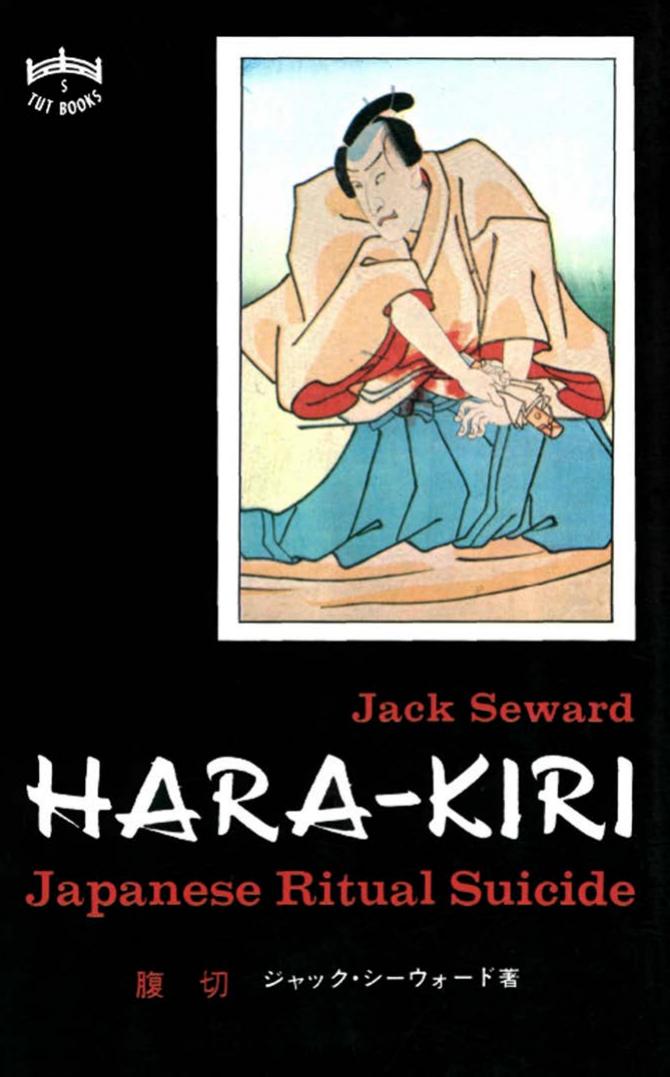Hara-Kiri: Japanese Ritual Suicide by Jack Seward

Author:Jack Seward [Seward, Jack]
Language: eng
Format: epub, pdf
Tags: History, Asia, Japan, Military, Non-Fiction, Social Science, Anthropology, Cultural
ISBN: 9781462907625
Google: ThLRAgAAQBAJ
Amazon: B008QXBUQQ
Barnesnoble: B008QXBUQQ
Goodreads: 16444269
Publisher: Tuttle Publishing
Published: 1968-06-15T00:00:00+00:00
Kaishaku
The word kaishaku means "to attend," "to look after," or "to serve." In the course of time, this term came to be used solely to refer to the act of helping a samurai in committing seppuku and lessening his long drawn-out agony. During the Warfare Period, there were many cases of kaishaku to help shorten the period of agony after disembowelment. It was, however, from the time of the fourth Shogun, Tokugawa Ietsuna, during the Empo Era (1673— 81) that kaishaku was officially established as a part of the seppuku ceremony. In the course of time, even the assistant himself came to be designated by the same word.
The basic motive of kaishaku was one of mercy, at least from the viewpoint of the feudal code of the samurai. Though seppuku was considered the flower of Bushido or chivalry, it was believed needless and even cruel, except on the actual battlefield, to let the disemboweler suffer lengthy agony. Thus, kaishaku was officially approved and introduced into the seppuku ceremony.
Whatever the standing or rank of the kaishaku-nin, the seppuku performer had to follow his orders, although there were customs and standards varying with the rank and offense of the condemned.
The kaishaku-nin was expected not to excuse himself from performing this duty. Errors, clumsiness in swordsmanship, or lack of dignity, while not absolutely disgraceful, could detract from his reputation. Young samurai were most likely to make slips. If a senior samurai recommended in his stead a younger samurai solely to escape this onerous duty, it was considered to be an act of cowardice.
Earlier it was pointed out that the finest technique in kaishaku was to leave an uncut portion of skin at the throat to "retain the head." Herein lies the philosophy that distinguishes seppuku from mere decapitation. To be decapitated without the seppuku ceremony was a great dishonor to a samurai, because it was the punishment usually meted out to commoners.
The sentence of decapitation was given to such criminals as arsonists, bandits, murderers (for an ignoble cause), and persons guilty of crimes against the state. It was to make a clear distinction from these crimes that the rite of seppuku was initiated. Hence, it was important to employ a swordsman of the highest order so that the head would not be cut off completely at the first blow. For all that, it was nevertheless difficult to always "retain the head." In an attempt to succeed at this difficult task, persons appointed as kaishaku prepared for it with two exercises: lopping off the lower halves of leaves on low tree branches, and knocking off a head-like object placed on top of a sand bag.
The costume of the kaishaku-nin varied. If the seppuku performer was of high rank, the kaishaku-nin wore a new kamishimo which was the most formal attire. This applied to his subordinates as well. If the seppuku performer was of medium rank, the kaishaku-nin, together with his subordinates, wore only hakama. For a lower-ranking man who held neither remarkable status nor office, the aforementioned formalities were not observed by the kaishakunin or his subordinates.
Download
Hara-Kiri: Japanese Ritual Suicide by Jack Seward.pdf
This site does not store any files on its server. We only index and link to content provided by other sites. Please contact the content providers to delete copyright contents if any and email us, we'll remove relevant links or contents immediately.
| Grief & Bereavement | Hospice Care |
| Pet Loss | Suicide |
They Both Die at the End by Adam Silvera(9771)
Thirteen Reasons Why by Jay Asher(8846)
The Space Between by Michelle L. Teichman(6893)
Suicide Notes by Michael Thomas Ford(4788)
Tuesdays with Morrie by Mitch Albom(4732)
Suicide: A Study in Sociology by Emile Durkheim(2989)
The Checklist Manifesto by Atul Gawande(2810)
Tuesdays With Morrie by Mitch Albom(2723)
In the Woods by Tana French(2561)
Bossypants by Tina Fey(2498)
Robin by Dave Itzkoff(2413)
Olive Kitteridge by Elizabeth Strout(2339)
No Ashes in the Fire by Darnell L Moore(2318)
Reservoir 13 by Jon McGregor(2264)
End of Days by Sylvia Browne(2147)
All Things New by John Eldredge(2134)
Bus on Jaffa Road by Mike Kelly(2124)
Scar Tissue by Anthony Kiedis(2109)
No Time to Say Goodbye(2080)
